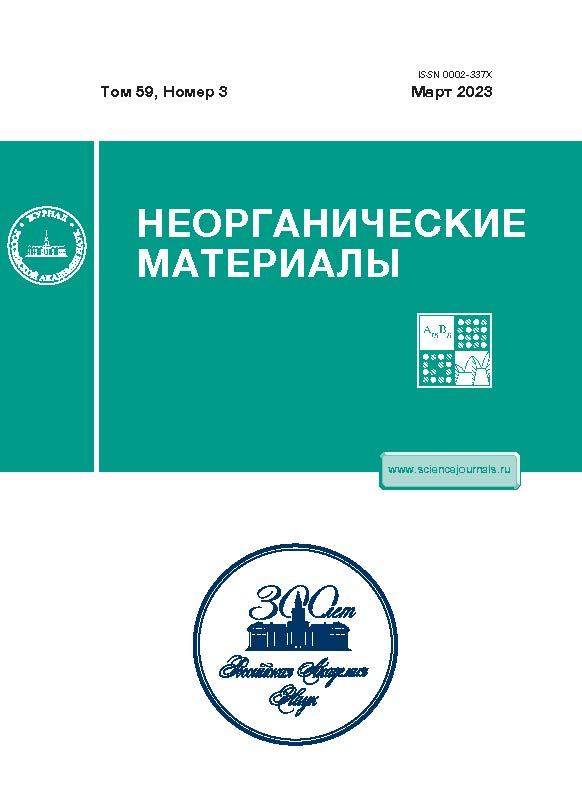Effect of Ultrasonic Treatment on the Surface Topography of Quartz Glass
- 作者: Lunin B.S.1, Nikolaev A.L.1
-
隶属关系:
- Moscow State University, 119991, Moscow, Russia
- 期: 卷 59, 编号 3 (2023)
- 页面: 317-322
- 栏目: Articles
- URL: https://medjrf.com/0002-337X/article/view/668317
- DOI: https://doi.org/10.31857/S0002337X23030090
- EDN: https://elibrary.ru/YSQBVE
- ID: 668317
如何引用文章
详细
This paper presents our results on ultrasound-induced changes in the surface topography of quartz glass studied using the Allan variance method. The use of this method has made it possible to quantitatively assess roughness components corresponding to surface defects of particular size. Prolonged ultrasonic treatment of quartz glass plates at a power density of 10 W/cm2 has been shown to cause significant changes in surface roughness: the profile height due to small surface defects, 0.125 μm in size, increased by about 40% and the one due to large defects (12 μm) decreased by about 30%. The observed changes in surface topography seem to be related to cavitation destruction of large surface defects by local cumulative jets.
关键词
作者简介
B. Lunin
Moscow State University, 119991, Moscow, Russia
Email: luninboris@yandex.ru
Россия, 119991, Москва, Ленинские горы, 1
A. Nikolaev
Moscow State University, 119991, Moscow, Russia
编辑信件的主要联系方式.
Email: luninboris@yandex.ru
Россия, 119991, Москва, Ленинские горы, 1
参考
- Bu X., Alheshibri M. The Effect of Ultrasound on Bulk and Surface Nanobubbles: A Review of the Current Status // Ultrason. Sonochem. 2021. V. 76. P. 105629. https://doi.org/10.1016/j.ultsonch.2021.105629
- Kruszelnicki M., Hassanzadeh A., Legawiec K.J., Polowczyk I., Kowalczuk P.B. Effect of Ultrasound Pre-Treatment on Carbonaceous Copper-Bearing Shale Flotation // Ultrason. Sonochem. 2022. V. 84. P. 105962. https://doi.org/10.1016/j.ultsonch.2022.105962
- Lyubimova T., Rybkin K., Oscar Fattalov O., Kuchinskiy M., Filippov L. Experimental Study of Temporal Dynamics of Cavitation Bubbles Selectively Attached to the Solid Surfaces of Different Hydrophobicity under the Action of Ultrasound // Ultrasonics. 2021. V. 117. P. 106516. https://doi.org/10.1016/j.ultras.2021.106516
- Novikova L., Ayrault P., Fontaine C., Chatel G., Jérôme F., Belchinskaya L. Effect of Low Frequency Ultrasound on the Surface Properties of Natural Aluminosilicates // Ultrason. Sonochem. 2016. V. 31. P. 598–609. https://doi.org/10.1016/j.ultsonch.2016.02.014
- Lee J., Yasui K., Ashokkumar M., Kentish S.E. Quantification of Cavitation Activity by Sonoluminescence to Study the Sonocrystallization Process under Different Ultrasound Parameters // Cryst. Growth. Des. 2018. V. 18. P. 5108–5115. https://doi.org/10.1021/acs.cgd.8b00547
- Аганин А.А., Гусева Т.С., Косолапова Л.А., Малахов В.Г. Динамика пузырька и импульсное нагружение твердой поверхности при акустическом воздействии // Уч. зап. Казан. ун-та. Сер. физ.-мат. науки. 2021. Т. 163. С. 31–47. https://doi.org/10.26907/2541-7746.2021.1.31-47
- Аганин А.А., Косолапова Л.А., Малахов В.Г. Динамика пузырька газа в жидкости вблизи твердой поверхности // Уч. зап. Казан. ун-та. Сер. физ.-мат. науки. 2018. Т. 160. Вып. 1. С. 154–164.
- Шероховатость поверхности. Параметры и характеристики. ГОСТ 2789-73. Стандартинформ. 2006.
- Айман О. Динамика формирования поверхностной шероховатости при обработке свободным абразивом // Дис. … к.т.н. 05.11.07. С-П.: Университет ИТМО, 2005. 131 с.
- Miller P.E., Suratwala T.I., Wong L.L., Feit M.D., Menapace J.A., Davis P.J., Steele R.A. The Distribution of Subsurface Damage in Fused Silica // Laser-Induced Damage Opt. Mater. 2005. V. 5991. P. 599101. https://doi.org/10.1117/12.638821
- Patrikar R.M. Modeling and Simulation of Surface Roughness // Appl. Surf. Sci. 2004. V. 228. № 1–4. P. 213–220. https://doi.org/10.1016/j.apsusc.2004.01.010
- Pfeifer P. Fractal Dimension as Working Tool for Surface-roughness Problems //Appl. Surf. Sci. 1984. V. 18. № 1–2. P. 146–164.
- Jahn R., Truckenbrodt H. A Simple Fractal Analysis Method of the Surface Roughness // J. Mater. Process. Technol. 2004. V. 145. № 1. P. 40–45. https://doi.org/10.1016/S0924-0136(03)00860-4
- Панасюк Г.П., Козерожец И.В., Ворошилов И.Л., Ивакин Ю.Д., Привалов В.И., Данчевская М.Н. Формы воды на поверхности и в объеме диоксида кремния // Журн. неорган. химии. 2021. Т. 66. № 5. С. 623–630. https://doi.org/10.31857/S0044457X21050123
- Banes J.A. Characterization of Frequency Stability // IEEE Trans. Instrum. Meas. 1971. IM-20. № 2. P. 105–120.
- Zhou D., Xu P., Gu Q. Stochastic Nested Variance Reduction for Nonconvex Optimization // J. Mach. Learn. Res. 2020. V. 21. № 1. P. 4130–4192.
- Ma Y., Hu Y., Qiao S., He Y., Tittel F.K. Trace Gas Sensing Based on Multi-Quartz-Enhanced Photothermal Spectroscopy // Photoacoustics. 2020. V. 20. P. 100206. https://doi.org/10.1016/j.pacs.2020.100206
- Wang P., Luan C-Y., Qiao M., Um M., Zhang J. Single Ion Qubit with Estimated Coherence Time Exceeding One Hour // Nature Commin. 2021. V. 12. 233. https://doi.org/10.1038/s41467-020-20330-w
- ALAMATH. Allan Variance Software. URL: http://www.alavar.org/.
- Флинн Г. Физика акустической кавитации в жидкостях // Физическая акустика / Под ред. Мэзона У. М.: Мир, 1967. Т. 1. С. 7–138.
- Нумачи Ф. Экспериментальное исследование кавитации, возбуждаемой ультразвуком // Труды американского общества Инженеров механиков. Теоретические основы инженерных расчетов. Сер.Д. 1965. № 4. С. 128–139.
- Kornfeld M., Suvorov L. On the Destructive Action of Cavitation // J. Appl. Phys. 1944. V. 15. № 3. P. 495–497.
- Peng C., Tian S., Li G., Wei M. Enhancement of Cavitation Intensity and Erosion Ability of Submerged Cavitation Jet by Adding Micro-Particles // Ocean Eng. 2020. V. 209. P. 107516. https://doi.org/10.1016/j.oceaneng.2020.107516
- Tan K.L., Yeo S.H. Bubble Dynamics and Cavitation Intensity in Milli-Scale Channels under an Ultrasonic Horn // Ultrason. Sonochem. 2019. V. 58. P. 104666. https://doi.org/10.1016/j.ultsonch.2019.104666
- Roylance D. Introduction to Fracture Mechanics // URL: www.pharmacoengineering.com/wp-content/upload/ 2018/03/MIT3_11F99_frac.pdf
- Ma G., Xia W., Xie G., Peng Y. Ultrasound-Assisted Detachment Behavior of Glass Beads and Fragments from a Fixed Bubble //Powder Technol. 2019. V. 355. P. 611–616. https://doi.org/10.1016/j.powtec.2019.07.092












